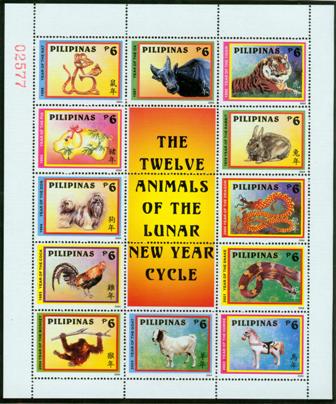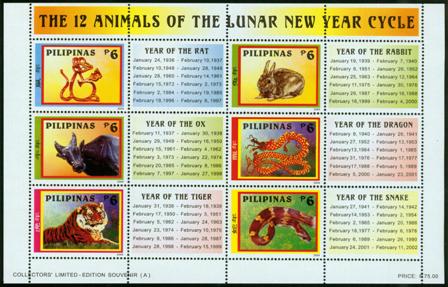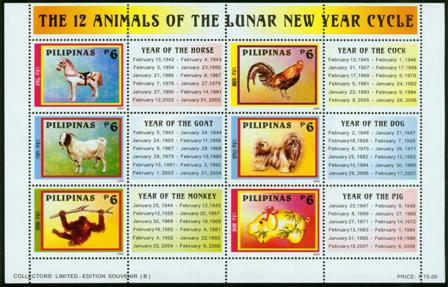2004, September 9. The Twelve Animals of the Lunar Year Cycle
Litho Offset. Amstar Company, Inc., Perf. 14.
Se-tenant Sheets of 12 + 3 labels, Two Souvenir Sheets of 6 + 6 labels



Se-tenant Miniature Sheets of 12 + 3 Labels (12,500)
6p Year of the Rat
6p Year of the Ox
6p Year of the Tiger
6p Year of the Rabbit
6p Year of the Dragon
6p Year of the Snake
6p Year of the Horse
6p Year of the Goat
6p Year of the Monkey
6p Year of the Rooster
6p Year of the Dog
6p Year of the Pig
Souvenir Sheets of 6 + 6 labels (5,000) (Sold at 75p)
6p Year of the Rat
6p Year of the Ox
6p Year of the Tiger
6p Year of the Rabbit
6p Year of the Dragon
6p Year of the Snake
Souvenir Sheets of 6 + 6 labels (5,000) (Sold at 75p)
6p Year of the Horse
6p Year of the Goat
6p Year of the Monkey
6p Year of the Rooster
6p Year of the Dog
6p Year of the Pig
Designer: David U. Dujunco
Design Coordinator: Dr. Ngo Tiong Tak
Design: Modified versions of 12 animal designs featured in previous series of New Year Stamps
First Day Covers: Manila
The Twelve Animals of the Lunar Year Cycle
Beginning 1991, Philpost has issued a set of stamps for every Chinese New Year, featuring the animal associated with the coming Lunar New Year, also commonly referred to as Chinese New Year). The first set of two stamps was issued in December of 1991 to usher in the Year of the Monkey, which starts on February 4, 1992. From 1992 to 2003, a set of two stamps and two souvenir sheets (one perforated and the other imperforate) were issued.
Since a complete cycle has already been issued it was deemed appropriate for Philpost to issue a collective sheet featuring all the twelve animals in a complete Lunar New Year Cycle. The two special souvenir sheets have adjoining labels listing the dates that each Lunar New Year begins and ends in the Western calendar. These two souvenir sheets each has total face values of 36p but they are being sold at 75p each. The premium is earmarked for the Philpost Philatelic Reserve Fund (PPRF), which will be used for the development and promotion of Philippine Philately.
The origin of the twelve animal signs is not very clear. But most legends credit Buddha (circa 563 - 483 B.C.) with the creation of the twelve animal cycle. Supposedly, he invited all the animals in jungle to visit him, but for some reason, only twelve came. To thank them, Buddha gave each animal a year which would be dedicated to that animal alone. The years were allocated in the order in which the animals arrived. The 12 animals appeared in this order: rat, ox, tiger, rabbit, dragon, snake, horse, goat, monkey, cock, dog and pig.
The cycle of the animals repeats itself every 12 years.
The Chinese calendar is based on the lunar year (orbits of the moon around the Earth). The Western calendar is based on the solar year (orbits of the Earth around the Sun). The two do not correspond exactly. Each Lunar New Year, therefore, begins on a slightly different date of the Solar Year.
-
Chinese New Year
-
Animals